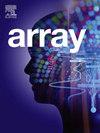Attention-enhanced hybrid CNN–LSTM network with self-adaptive CBAM for COVID-19 diagnosis
IF 4.5
Q2 COMPUTER SCIENCE, THEORY & METHODS
引用次数: 0
Abstract
Accurate identification of COVID-19 still presents difficulties due to the limitations of RT-PCR testing, such as reduced sensitivity and restricted availability. Chest X-Ray (CXR) imaging modalities, combined with deep learning models, offer a non-invasive solution. However, baseline Convolutional Neural Network (CNN) commonly faced obstacles to fully capture the temporal dependencies present in sequential medical imaging data, limiting their diagnostic performance. To address this, we propose Dual-Attention CNN-LSTM, an innovative hybrid deep learning model designed to enhance COVID-19 detection from CXR images. This model synergizes CNN's spatial feature extraction capabilities with the sequential learning strengths of Long Short-Term Memory (LSTM), further enhanced by the proposed Self-Adaptive Convolutional Block Attention Module (SA-CBAM) and Multi-Head Attention (MHA). SA-CBAM enables CNN to selectively focus on critical lung abnormalities, while MHA empowers LSTM to capture temporal dependencies and dynamic variations in imaging sequences. By fusing these attention-optimized features, Dual-Attention CNN-LSTM delivers an unprecedented level of robustness in CXR classification. Additionally, this study introduces five pre-trained-LSTM models, leveraging transfer learning to enhance CXR pattern recognition and serving as comparative models for the proposed Dual-Attention CNN-LSTM. Our comprehensive evaluation across multiple baseline models for three-class classification (normal, pneumonia, COVID-19) demonstrates that Dual-Attention CNN-LSTM surpasses state-of-the-art performance, achieving a remarkable weighted accuracy of 99.97 %, with precision, recall, specificity, F1-score, and MCC all exceeding 99.95 %. These findings highlight the potential of our approach as a transformative tool for accurate and early disease diagnosis, ultimately improving clinical decision-making and patient outcomes.
基于自适应CBAM的注意力增强CNN-LSTM混合网络新冠肺炎诊断
由于RT-PCR检测的局限性,例如灵敏度降低和可用性受限,准确识别COVID-19仍然存在困难。胸部x射线(CXR)成像模式与深度学习模型相结合,提供了无创解决方案。然而,基线卷积神经网络(CNN)通常面临着完全捕获序列医学成像数据中存在的时间依赖性的障碍,限制了它们的诊断性能。为了解决这个问题,我们提出了一种创新的混合深度学习模型CNN-LSTM,旨在增强从CXR图像中检测COVID-19的能力。该模型将CNN的空间特征提取能力与长短期记忆(LSTM)的顺序学习优势协同起来,并通过提出的自适应卷积块注意模块(SA-CBAM)和多头注意(MHA)进一步增强。SA-CBAM使CNN能够选择性地关注关键的肺部异常,而MHA使LSTM能够捕获成像序列的时间依赖性和动态变化。通过融合这些注意力优化的特征,双注意力CNN-LSTM在CXR分类中提供了前所未有的鲁棒性。此外,本研究引入了五种预训练的lstm模型,利用迁移学习来增强CXR模式识别,并作为所提出的双注意CNN-LSTM的比较模型。我们对三类分类(正常、肺炎、COVID-19)的多个基线模型进行了综合评估,结果表明,双注意力CNN-LSTM的加权准确率达到了99.97%,准确率、召回率、特异性、f1评分和MCC都超过了99.95%。这些发现突出了我们的方法作为准确和早期疾病诊断的变革性工具的潜力,最终改善临床决策和患者预后。
本文章由计算机程序翻译,如有差异,请以英文原文为准。
求助全文
约1分钟内获得全文
求助全文

 求助内容:
求助内容: 应助结果提醒方式:
应助结果提醒方式:


